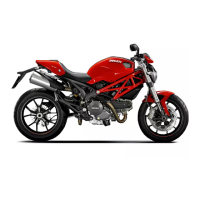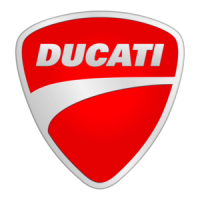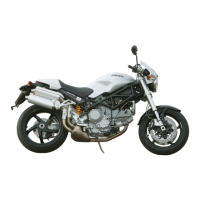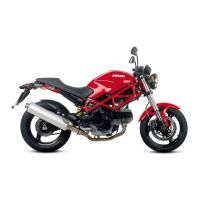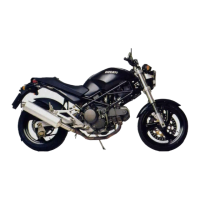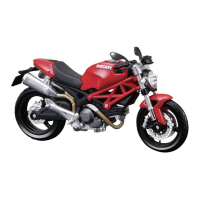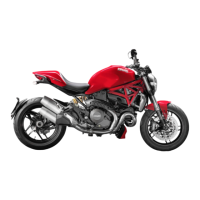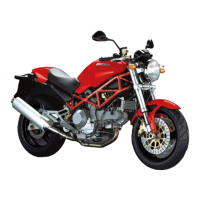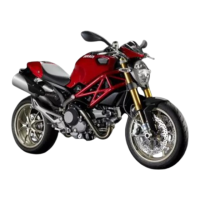Do you have a question about the Ducati MONSTER 797 2017 and is the answer not in the manual?
Guidance for safe motorcycle operation and maintenance.
Explanation of warning symbols and notes for safe operation.
Specifies the approved riding surfaces and limitations for the motorcycle.
Legal requirements, alcohol/drug use, and helmet use mandates.
Emphasizes the need for training to prevent accidents due to inexperience.
Recommendations for essential riding gear like helmet, jacket, gloves, and boots.
Steps for refuelling, fuel compatibility, and safety precautions.
Information on load capacity, weight distribution, and securing luggage.
Precautions for handling used engine oil and potential health risks.
Hazards associated with brake fluid and contact precautions.
Dangers of coolant ignition and contact with hot parts.
How to find the engine number for identification and spare parts ordering.
Explanation of warning lights, neutral, high beam, fuel, and turn indicators.
Understanding MIL, ABS, and generic error warning lights.
Indicators for engine over-revving and immobilizer system status.
Definitions of key technological terms, including ABS.
Procedure for setting and displaying parameters on the instrument panel.
Information shown on the main screen: speed, menus, rev counter, and warning lights.
Display of average speed (SPEED AVG).
Procedure to enter the Setting Menu, requiring low vehicle speed.
System response when the key is not recognized, involving the PIN code.
List of customizable functions accessible via the Setting Menu.
How speed is calculated, displayed, and error indications.
Display of engine revolutions per minute (RPM) via bargraph and numerical value.
How the odometer counts and displays total distance travelled.
Partial distance tracking for fuel consumption and trip time calculations.
Second partial distance meter for tracking travel information.
Distance covered since the low fuel light activated.
How trip time is calculated and reset, linked to TRIP1.
Procedure for setting the motorcycle's clock time and its display format.
How average speed is calculated and displayed on the instrument panel.
DMS features, Bluetooth connection status, and menu access.
Managing incoming calls, recall function, and call termination.
Activating, controlling, and managing the music player via the instrument panel.
Resolving issues with notifications, earphone connection, and music playback.
How the 'SERVICE' indicator alerts the rider for scheduled maintenance.
Indication for the first oil service at 1000 km.
Display of remaining mileage or days until next scheduled service.
Indicators for Oil Service, Date Service, and Desmo Service requirements.
How the instrument panel alerts the rider to potential issues during operation.
Warning for low battery voltage and recommended charging action.
How to enter the Setting Menu and list of available functions.
Procedures for activating and modifying the motorcycle's PIN code.
Step-by-step guide to activate a new PIN code for the motorcycle.
Instructions on how to change an existing PIN code.
Adjusting the intensity of the instrument panel's backlighting.
Procedure for setting the motorcycle's clock time and its display format.
Setting the year, month, and day for the motorcycle's calendar.
Viewing remaining time or mileage until next Desmo, Oil, or Annual Service.
Procedure to enable or disable the Anti-lock Braking System (ABS).
Changing units for speed and temperature display.
Selecting units for speed and distance measurement.
Selecting units for temperature display.
Restoring default units of measurement for all displayed values.
Monitoring the motorcycle's battery voltage levels and indications.
Displaying engine RPM in a precise digital format.
Steps to associate Bluetooth devices like smartphones and navigators.
Steps to associate Bluetooth devices with the motorcycle's system.
Procedure to remove previously paired Bluetooth devices.
How to switch between low and high beam headlights.
Automatic and manual reset functions for turn indicators.
Activating the hazard lights for emergency signaling.
How the electronic engine block system protects against theft.
Description of the motorcycle keys, their functions, and operation.
Process for obtaining spare keys from an authorized dealer.
Using the PIN code to temporarily restore motorcycle operation.
Diagram and list of control locations on the motorcycle handlebars and pedals.
Description of ignition switch positions and steering lock mechanism.
Operation of lights, menu navigation, and turn indicators on the left switch.
Function of the clutch lever in disengaging the engine from the transmission.
Checking and adjusting the free play in the clutch lever for optimal operation.
Operation of the Red ON/OFF switch and Hazard button.
How the throttle twistgrip controls engine speed and idle.
Operating the front brake and adjusting the lever position.
How to operate the rear brake pedal for stopping.
Using the gear change pedal for shifting gears up and down.
Adjusting gear change and rear brake pedal positions for rider comfort.
Locating key parts like tank filler plug, seat lock, and side stand.
Opening and closing the fuel tank filler plug securely.
Opening and closing the seat lock to access under-seat compartment.
Correct usage of the side stand and associated safety precautions.
Functionality of the Bluetooth unit as a hub for electronic devices.
Location and usage of the USB connection port for charging accessories.
How to adjust damping and spring preload on the rear shock absorber.
Guidelines for the initial break-in period for engine, brakes, and suspensions.
Essential checks before riding for safety and damage prevention.
Steps to start the engine safely, including checks and warnings.
Instructions for starting from a standstill and shifting gears.
Proper braking methods using front/rear brakes and engine braking.
Procedure for safely stopping the engine and turning off the ignition.
Guidelines for refuelling, fuel compatibility, and safety precautions.
Steps for parking, theft prevention, and ensuring proper ventilation.
Contents of the onboard tool kit for minor repairs and adjustments.
Recommendation to have air filter maintenance performed by a dealer.
How to check and maintain correct brake fluid levels in reservoirs.
Procedure for checking brake pad thickness and replacement guidelines.
Steps for removing and charging the motorcycle battery.
Using a battery maintainer for long-term storage and preventing sulphation.
Periodic lubrication of throttle and side stand cables for smooth operation.
Procedure for adjusting the throttle grip's free play.
How to measure and ensure correct drive chain tension.
Proper lubrication of the O-ring drive chain using specific lubricants.
Steps for replacing burnt-out bulbs in turn indicators.
Procedure for checking and adjusting headlight aiming for optimal visibility.
Manually adjusting rear-view mirrors for optimal viewing angle.
Recommended tyre pressures, checking for damage, and repair/replacement guidelines.
Specification for minimum legal tread depth on tires.
How to check engine oil level using the sight glass.
Specifications for engine oil viscosity, API, and JASO ratings.
Importance of spark plugs and recommendation for professional replacement.
Guidelines for washing and cleaning the motorcycle's exterior components.
Scheduled maintenance tasks to be performed by authorized dealers.
Routine maintenance tasks recommended for the customer.
Vehicle weight specifications and maximum allowed load.
Overall dimensions of the motorcycle, including length, height, and wheelbase.
Specifications for fuel, engine oil, brake fluid, and fork oil.
Details on engine type, bore, stroke, displacement, and power output.
Description of the Desmodromic timing system components.
Information on maximum speed and torque, with running-in advice.
Details on injection system, throttle body, and fuel supply.
Technical details of front and rear brake systems, including ABS.
Gear ratios, drive chain type, and clutch information.
Information on the frame structure, steering geometry, and wheel sizes.
Tyre types, sizes, and radial construction.
Information on front fork and rear shock absorber types and adjustments.
Details of the exhaust system, silencer, and catalytic converter.
List of available motorcycle colours and their associated paint codes.
Description of headlights, lighting, horn, battery, and generator specifications.
Location and identification of fuses in the fuse box and on the remote switch.
Key to understanding wire colours used in the electric system wiring diagram.
Guidance for safe motorcycle operation and maintenance.
Explanation of warning symbols and notes for safe operation.
Specifies the approved riding surfaces and limitations for the motorcycle.
Legal requirements, alcohol/drug use, and helmet use mandates.
Emphasizes the need for training to prevent accidents due to inexperience.
Recommendations for essential riding gear like helmet, jacket, gloves, and boots.
Steps for refuelling, fuel compatibility, and safety precautions.
Information on load capacity, weight distribution, and securing luggage.
Precautions for handling used engine oil and potential health risks.
Hazards associated with brake fluid and contact precautions.
Dangers of coolant ignition and contact with hot parts.
How to find the engine number for identification and spare parts ordering.
Explanation of warning lights, neutral, high beam, fuel, and turn indicators.
Understanding MIL, ABS, and generic error warning lights.
Indicators for engine over-revving and immobilizer system status.
Definitions of key technological terms, including ABS.
Procedure for setting and displaying parameters on the instrument panel.
Information shown on the main screen: speed, menus, rev counter, and warning lights.
Display of average speed (SPEED AVG).
Procedure to enter the Setting Menu, requiring low vehicle speed.
System response when the key is not recognized, involving the PIN code.
List of customizable functions accessible via the Setting Menu.
How speed is calculated, displayed, and error indications.
Display of engine revolutions per minute (RPM) via bargraph and numerical value.
How the odometer counts and displays total distance travelled.
Partial distance tracking for fuel consumption and trip time calculations.
Second partial distance meter for tracking travel information.
Distance covered since the low fuel light activated.
How trip time is calculated and reset, linked to TRIP1.
Procedure for setting the motorcycle's clock time and its display format.
How average speed is calculated and displayed on the instrument panel.
DMS features, Bluetooth connection status, and menu access.
Managing incoming calls, recall function, and call termination.
Activating, controlling, and managing the music player via the instrument panel.
Resolving issues with notifications, earphone connection, and music playback.
How the 'SERVICE' indicator alerts the rider for scheduled maintenance.
Indication for the first oil service at 1000 km.
Display of remaining mileage or days until next scheduled service.
Indicators for Oil Service, Date Service, and Desmo Service requirements.
How the instrument panel alerts the rider to potential issues during operation.
Warning for low battery voltage and recommended charging action.
How to enter the Setting Menu and list of available functions.
Procedures for activating and modifying the motorcycle's PIN code.
Step-by-step guide to activate a new PIN code for the motorcycle.
Instructions on how to change an existing PIN code.
Adjusting the intensity of the instrument panel's backlighting.
Procedure for setting the motorcycle's clock time and its display format.
Setting the year, month, and day for the motorcycle's calendar.
Viewing remaining time or mileage until next Desmo, Oil, or Annual Service.
Procedure to enable or disable the Anti-lock Braking System (ABS).
Changing units for speed and temperature display.
Selecting units for speed and distance measurement.
Selecting units for temperature display.
Restoring default units of measurement for all displayed values.
Monitoring the motorcycle's battery voltage levels and indications.
Displaying engine RPM in a precise digital format.
Steps to associate Bluetooth devices like smartphones and navigators.
Steps to associate Bluetooth devices with the motorcycle's system.
Procedure to remove previously paired Bluetooth devices.
How to switch between low and high beam headlights.
Automatic and manual reset functions for turn indicators.
Activating the hazard lights for emergency signaling.
How the electronic engine block system protects against theft.
Description of the motorcycle keys, their functions, and operation.
Process for obtaining spare keys from an authorized dealer.
Using the PIN code to temporarily restore motorcycle operation.
Diagram and list of control locations on the motorcycle handlebars and pedals.
Description of ignition switch positions and steering lock mechanism.
Operation of lights, menu navigation, and turn indicators on the left switch.
Function of the clutch lever in disengaging the engine from the transmission.
Checking and adjusting the free play in the clutch lever for optimal operation.
Operation of the Red ON/OFF switch and Hazard button.
How the throttle twistgrip controls engine speed and idle.
Operating the front brake and adjusting the lever position.
How to operate the rear brake pedal for stopping.
Using the gear change pedal for shifting gears up and down.
Adjusting gear change and rear brake pedal positions for rider comfort.
Locating key parts like tank filler plug, seat lock, and side stand.
Opening and closing the fuel tank filler plug securely.
Opening and closing the seat lock to access under-seat compartment.
Correct usage of the side stand and associated safety precautions.
Functionality of the Bluetooth unit as a hub for electronic devices.
Location and usage of the USB connection port for charging accessories.
How to adjust damping and spring preload on the rear shock absorber.
Guidelines for the initial break-in period for engine, brakes, and suspensions.
Essential checks before riding for safety and damage prevention.
Steps to start the engine safely, including checks and warnings.
Instructions for starting from a standstill and shifting gears.
Proper braking methods using front/rear brakes and engine braking.
Procedure for safely stopping the engine and turning off the ignition.
Guidelines for refuelling, fuel compatibility, and safety precautions.
Steps for parking, theft prevention, and ensuring proper ventilation.
Contents of the onboard tool kit for minor repairs and adjustments.
Recommendation to have air filter maintenance performed by a dealer.
How to check and maintain correct brake fluid levels in reservoirs.
Procedure for checking brake pad thickness and replacement guidelines.
Steps for removing and charging the motorcycle battery.
Using a battery maintainer for long-term storage and preventing sulphation.
Periodic lubrication of throttle and side stand cables for smooth operation.
Procedure for adjusting the throttle grip's free play.
How to measure and ensure correct drive chain tension.
Proper lubrication of the O-ring drive chain using specific lubricants.
Steps for replacing burnt-out bulbs in turn indicators.
Procedure for checking and adjusting headlight aiming for optimal visibility.
Manually adjusting rear-view mirrors for optimal viewing angle.
Recommended tyre pressures, checking for damage, and repair/replacement guidelines.
Specification for minimum legal tread depth on tires.
How to check engine oil level using the sight glass.
Specifications for engine oil viscosity, API, and JASO ratings.
Importance of spark plugs and recommendation for professional replacement.
Guidelines for washing and cleaning the motorcycle's exterior components.
Scheduled maintenance tasks to be performed by authorized dealers.
Routine maintenance tasks recommended for the customer.
Vehicle weight specifications and maximum allowed load.
Overall dimensions of the motorcycle, including length, height, and wheelbase.
Specifications for fuel, engine oil, brake fluid, and fork oil.
Details on engine type, bore, stroke, displacement, and power output.
Description of the Desmodromic timing system components.
Information on maximum speed and torque, with running-in advice.
Details on injection system, throttle body, and fuel supply.
Technical details of front and rear brake systems, including ABS.
Gear ratios, drive chain type, and clutch information.
Information on the frame structure, steering geometry, and wheel sizes.
Tyre types, sizes, and radial construction.
Information on front fork and rear shock absorber types and adjustments.
Details of the exhaust system, silencer, and catalytic converter.
List of available motorcycle colours and their associated paint codes.
Description of headlights, lighting, horn, battery, and generator specifications.
Location and identification of fuses in the fuse box and on the remote switch.
Key to understanding wire colours used in the electric system wiring diagram.
| Power | 75 hp (55 kW) @ 8, 250 rpm |
|---|---|
| Fuel Injection | Electronic fuel injection, 50 mm throttle body |
| Transmission | 6-speed |
| Frame | Tubular steel Trellis frame |
| Rear Brakes | 245 mm disc, 1-piston caliper |
| ABS | Standard |
| Engine Type | L-Twin, Desmodromic distribution, air cooled |
| Torque | 50 lb-ft (68 Nm) @ 5, 750 rpm |
| Front Suspension | 43 mm Kayaba upside-down forks |
| Rear Suspension | adjustable preload and rebound |
| Front Brakes | 2 x 320 mm discs, 4-piston radial calipers |
| Dry Weight | 175 kg (386 lbs) |
| Seat Height | 805 mm (31.7 in) |
| Fuel Tank Capacity | 16.5 l (4.3 US gal) |
